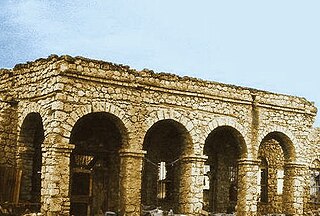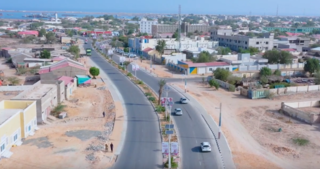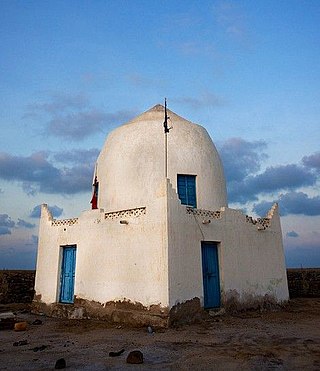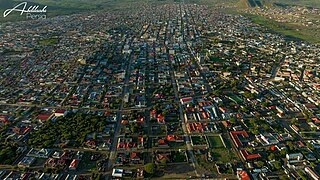Related Research Articles

The Horn of Africa (HoA), also known as the Somali Peninsula, is a large peninsula and geopolitical region in East Africa. Located on the easternmost part of the African mainland, it is the sixth largest peninsula in the world. It is composed of Ethiopia, Eritrea, Somalia, Djibouti and Somaliland; broader definitions also include parts or all of Kenya, Sudan, South Sudan, and Uganda. The term Greater Horn Region (GHR) can additionally include Burundi, Rwanda, and Tanzania. It lies along the southern boundary of the Red Sea and extends hundreds of kilometres into the Guardafui Channel, Gulf of Aden, and Indian Ocean and shares a maritime border with the Arabian Peninsula of West Asia.

Awdal is an administrative region (gobol) in western Somaliland. It was separated from Woqooyi Galbeed and became a province in 1984 and is the most northwesterly province of Somaliland. To the east it borders Maroodi Jeex and Sahil; to its north-west it borders Djibouti; to its south and south-west lies Ethiopia; and the Gulf of Aden to its north. The province has an estimated population of 1,010,566. The region comprises the four districts of Borama, the regional capital, Baki, Lughaya, and Zeila.

The Adal Sultanate also known as the Adal Empire, or Bar Saʿad dīn was a medieval Sunni Muslim Empire which was located in the Horn of Africa. It was founded by Sabr ad-Din III on the Harar plateau in Adal after the fall of the Sultanate of Ifat. The kingdom flourished c. 1415 to 1577. At its height, the polity under Sultan Badlay controlled the territory stretching from Cape Guardafui in Somalia to the port city of Suakin in Sudan. The Adal Empire maintained a robust commercial and political relationship with the Ottoman Empire. Sultanate of Adal was alternatively known as the federation of Zeila.

Berbera is the capital of the Sahil region of Somaliland and is the main sea port of the country, located approximately 160 km from the national capital, Hargeisa. Berbera is a coastal city and was the former capital of the British Somaliland protectorate before Hargeisa. It also served as a major port of the Ifat, Adal and Isaaq sultanates from the 13th to 19th centuries.

Practitioners of Islam first entered Somalia in the northwestern city of Zeila during prophet Muhammad's lifetime whereupon they built the Masjid al-Qiblatayn; as such, Islam has been a part of Somali society since the 7th century.

The Isaaq is a major Somali clan family. It is one of the largest Somali clan families in the Horn of Africa, with a large and densely populated traditional territory.

Zeila, also known as Zaila or Zayla, is a historical port town in the western Awdal region of Somaliland.
The Walashma dynasty was a medieval Muslim dynasty of the Horn of Africa founded in Ifat. Founded in the 13th century, it governed the Ifat and Adal Sultanates in what are present-day Somaliland, Somalia, Djibouti, Eritrea and eastern Ethiopia.
The Dir is one of the largest and most prominent Somali clans in the Horn of Africa. They are also considered to be the oldest Somali stock to have inhabited the region. Its members inhabit Djibouti, Somalia, Ethiopia, and northeastern Kenya.

The Gadabuursi, also known as Samaroon, is a northern Somali clan, a sub-division of the Dir clan family.

Borama is the largest city of the northwestern Awdal region of Somaliland. The commercial seat of the province, it is situated near the border with Ethiopia.

Islam in Djibouti has a long history, first appearing in the Horn of Africa during the lifetime of Muhammad. Today, 98% of Djibouti's 490,000 inhabitants are Muslims. According to Pew, 77% follow the denomination of Sunnism, whilst 8% are non-denominational Muslim, and the remaining 13% follow other sects such as Quranism, Shia, Ibadism etc.. After independence, the nascent republic constructed a legal system based in part on Islamic law.

Djibouti, officially the Republic of Djibouti, is a country in the Horn of Africa, bordered by Somalia to the south, Ethiopia to the southwest, Eritrea in the north, and the Red Sea and the Gulf of Aden to the east. The country has an area of 23,200 km2 (8,958 sq mi).
Abdirahman bin Isma'il al-Jabarti, also known as Daarood, Dawud or Da'ud, is the semi-legendary common ancestor of the Somali Darod clan and the Harla people. According to local tradition, Abdirahman descended from Aqil ibn Abi Talib, a member of the Banu Hashim and a cousin of the Islamic prophet Muhammad.
The predominant religion in Somalia is Islam, with tiny minorities of Christians, traditional African religions and others.

Somali nationalism is a nationalist ideology advocating for the unification of all Somali people who share a common ethnicity, language, and culture, under a single banner. Its earliest manifestations has its roots in the Middle Ages and the Adal Sultanate whilst in the contemporary era its often traced back to the Somali Youth League, a political organisation founded in 1943. The Somali Youth League became one of the most influential political parties in Somalia prior to post-independence. The Somali guerilla militia Al-Shabab is also noteworthy for incorporating Somali nationalism into its Islamist ideology.
Yusuf bin Ahmad al-Kawneyn, popularly known as Aw Barkhadle or Yusuf Al Kownayn, was an Islamic scholar and traveler based in Zeila. Based on reference to Yusuf Al Kawneyn in the Harar manuscripts, Dr. Enrico Cerulli.

The Isaaq Sultanate was a Somali kingdom that ruled parts of the Horn of Africa during the 18th and 19th centuries. It spanned the territories of the Isaaq clan in modern-day Somaliland and Ethiopia. The sultanate was governed by the Rer Guled branch of the Garhajis clan and is the pre-colonial predecessor to the modern Republic of Somaliland.

Sheikh Ishaaq bin Ahmed bin Muhammad bin al-Hussein al-Hashimi, more commonly known as Sheikh Ishaaq or Sheikh Isaaq was an Arabian sheikh and the Sayyid forefather of the Isaaq Somali clan-family in the Horn of Africa, whose traditional territory is wide and densely populated.

Somalis in Ethiopia refers to the ethnic Somalis from Ethiopia, particularly the Ogaden, officially known as the Somali Region. Their language is primarily Somali and are predominantly Muslim. According to a 2017 census from the Central Statistical Authority, the Somalis were the third largest ethnic group in Ethiopia with roughly 11,000,000 people accounting for 8.2% of the country’s population, after Oromo (34.4%) and Amhara (27%). The Somali population in Ethiopia make up around 30% of the total Somali population worldwide.
References
- ↑ Loiseau, Julien (31 Jul 2020). "Abyssinia at al-Azhar: Muslim Students from the Horn of Africa in Late Medieval Cairo". Northeast African Studies .
- ↑ Trimingham, J (1965). Islam in Ethiopia. Frank Cass. pp. 150–151. ISBN 0-7146-1731-8.
- ↑ Briggs, Phillip (2012). Somaliland. Bradt Travel Guides. p. 7. ISBN 978-1841623719.
- ↑ Encyclopedia Americana, Volume 25. Americana Corporation. 1965. p. 255.
- ↑ Somaliland Society (1954). The Somaliland Journal, Volume 1, Issues 1-3. The Society. p. 85.
- ↑ Tamrat, Taddesse (1972). Church and state in Ethiopia, 1270-1527. Clarendon Press. p. 124. ISBN 978-0-19-821671-1.
- ↑ Cerulli, Enrico. Islam yesterday and today (PDF). p. 169.